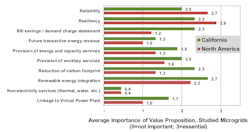In an effort to help commercialize microgrids, the California Energy Commission is analyzing lessons learned from nine microgrid case studies about projects that total 21 MW of peak capacity, with an average size of 2.25 MW.
The case studies are detailed in a new report being prepared for the commission by Navigant Research.
The state hopes to use the case studies to better target state research and development (R&D) funding to help California achieve its goals on “climate change, renewable energy, distributed energy resources (DER), and grid modernization via microgrids,”according to the report.
Also see “California Releases $44.7 Million for Microgrid Grants“
All of the projects incorporate solar photovoltaics and energy storage and are either in operation or are expected to be within a year. Their business models include power purchase agreements, owner financing and utility rate based-projects, according to the report, authored by Peter Asmus, associate director of energy for Navigant Research. Asmus said the report is still in draft form, and may be changed.
The commission had requested case histories that weren’t based on grant funding so that it could learn about models that can be most easily commercialized, according to Mike Gravely, deputy division chief of the commission’s R&D division. At least 50 percent of their funding came from private investment or non-governmental grants.
“The reason for doing this: These have a higher probability of being stable microgrids that won’t fall apart in the future,” said Gravely.
The commission compared the microgrid case histories from California to eight from other North American states. The broader group of microgrids total 30.8 MW of peak capacity, with an average size of 3.8 MW and feature a more diversified group of resources, including wind and biogas.
Other microgrid case studies
In comparing California microgrids to those in other North America states, Navigant found that the North America projects scored higher on reliability/resiliency due to California’s extreme weather events. California’s projects scored higher on demand charge and bill savings because the state has higher rates than most states, according to the report.
Credit: California Energy Commission
Gravely said he was particularly interested in the projects funded by the savings created by clean energy, including shared-savings projects in which a third party helps finance a project and then receives a portion of the energy savings each month.
As a next step, the commission will address the challenges of commercializing microgrids and create action items, said Gravely. About 15 to 20 action items have been identified by industry players who have participated in the roadmap efforts. The last meeting was July 26.
On the list of issues that need addressing is transactive energy, said Gravely.
“One issue is transactive energy and how does it affect microgrids? You can’t just have an action item saying, ‘We need transactive energy.’ We need to explain how it works. A section will do that.” Also needed is an action item making transactive energy open to microgrids, he said.
Transactive energy and microgrids
Transactive energy, he explained, involves customers and third parties participating in buying and selling energy on the grid and understanding the rules and tariffs, many of which are still under development.
“Transactive energy covers everything from electric vehicles participating in the market, to using home thermostats and doing demand response,” he said.
The commission also will focus on how microgrids can provide grid services, such as demand response.
One microgrid company at the workshop showed how the company’s microgrids could provide consistent responses to the needs of the grid, using energy storage, Gravely said. This was an example of storage being coupled with other technologies to provide consistent grid services, he said.
The California case studies included microgrid projects by a wastewater public agency, an agricultural operation, an affordable housing complex, the city of San Diego zoo, a Napa Valley winery, a Sonoma farm/winery, a military base, a commercial customer and a private school.
One of the big challenges in California is the lack of policy governing microgrids, even though microgrids meet the goals of the state’s aggressive climate change policies, Gravely said.
“We see the map as a tool to meet state policy goals, integrate DER and use microgrids as a tool to help us manage the grid,” he said. “We’re not responding to a bill, but the opportunity microgrids offer. How do we make this a commercially effective tool where people want to do it?”
The next step is to draft the roadmap, said Gravely. The next workshop will take place Oct. 2, where a draft roadmap will be discussed. A presentation summarizing the microgrid case studies is available on the commission’s site.
For more microgrid case studies, check out the Microgrid Knowledge library.








